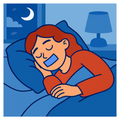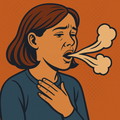Chronic Bloating, Reflux & Gas Relief
Through Myofunctional Therapy
Bloating
Burping
Flatulence
Coughing
Hiccupping
Acid reflux
Stomach aches
Irritable Bowel Syndrome - IBS
Orofacial Myofunctional Therapy IN Ottawa Can help
Discover the vital link between our eating habits and overall health. While the impact of food is commonly understood, the way we drink, chew, and swallow plays an equally crucial role.
Surprisingly, many digestive discomforts stem from swallowing air during meals. Bloating, belching, coughing, hiccupping, flatulence, stomach aches, and certain forms of acid reflux and IBS can all be influenced by this factor 34,49,50,51,52.
Orofacial Myofunctional Therapy (OMT) retrains these habits to reduce air swallowing (aerophagia) and ease digestive discomfort naturally and sustainably.
By retraining our drinking, chewing, and eating behaviors, we can find relief from these digestive discomforts.
Experience the soothing effects of Orofacial Myofunctional Therapy, which offers long-lasting benefits for your stomach and overall well-being.
Swallowing Air While Eating Causes discomfort
Soothe your stomach with our easy program
Aerophagia Definition: The swallowing of air, whether accidentally, or as an involuntary Habit.
Produces Uncomfortable Gastrointestinal Symptoms:34,49,50,51
Abdominal Distension
Bloating
Belching
Flatulence/Gas
Some Types of Acid Reflux & IBS

.jpg)
Causes of Air Swallowing
Eating or Drinking Quickly
Talking While Eating
Atypical Swallowing
Drinking Through a Straw
Daily Repetitive Oral Habit
Smoking
Carbonated Drinks
Orofacial Myofunctional Therapy's Steps to Stop Air Swallowing
Stop any daily repetitive habit involving the mouth (if any)
Stop mouth breathing. Change over to nasal breathing
Retrain drinking, chewing, and swallowing
Retrain sleeping with your mouth closed


Book a Free In-Person Consultation Today
What is Orofacial Myofunctional Therapy?
The mouth, head, and neck are a complex weave of muscles, tissues, joints, bones, blood vessels, and nerves that all need to work together for a smooth, discomfort-free daily function.
We are born and grow with little direction and training in this area of our bodies. We eat the way we eat, we chew on the side that is most comfortable, we swallow whichever way gets the food down, our tongues rest wherever they rest, we breathe the easier way, and we have repetitive habits that soothe our stress that can involve our faces and mouths.
All of these reflexive habits can create abnormalities in our oral and facial structures, and since we have been doing them throughout youthful growth, our bones and muscles have molded around these untrained habits, potentially creating ingrained disorders in our current and later years.
Orofacial Myofunctional Therapists specialize and only focus on the muscles and tissues throughout the tongue, jaw, face, head, and neck. Weekly exercises are given that either tone or relax these muscles and tissues aligning them to your center. Working from your foundation up, we progressively reset years of habits. Most individuals will complete the program within the year and yet your new symmetry could last your lifetime.
A Stanford University Systematic Review Revealed The Lasting Beneficial Effects Of Orofacial Myofunctional Therapy In A Wide Cohort:
“Current literature demonstrates that orofacial myofunctional therapy decreases apnea-hypopnea index by approximately 50% in adults and 62% in children. Improvements to snoring and daytime sleepiness. Shown effective in children and adults of all ages studied thus far; youngest patient 3 yrs old to 60 yrs old. Therapy has an important role in preventing relapse.”48
Frequently Asked Questions
1. Can poor chewing or swallowing habits really cause bloating and gas?
Yes. When you chew too quickly, eat with your mouth open, or breathe through your mouth while eating, excess air enters the digestive tract. This can lead to bloating, reflux, or gas. Orofacial Myofunctional Therapy retrains these patterns to reduce aerophagia and improve digestion.
2. What is aerophagia—and how is it treated?
Aerophagia is the unintentional swallowing of air, often during eating, drinking, or speaking. Therapy helps reduce this by correcting oral posture, chewing rhythm, and swallow timing.
3. How long until I feel better?
Many patients notice early improvements in bloating, reflux, or stomach discomfort within the first 6 months. Full benefits develop as therapy progresses and new habits become automatic.
4. Is this a substitute for digestive medications or GI treatment?
No—it’s complementary. Our therapy works best when digestive conditions have been medically evaluated. If no disorders are found, but symptoms persist, oral function could be the missing piece.
5. Is Orofacial Myofunctional Therapy covered by insurance?
Many extended health plans cover our sessions under code 05012. We’re happy to provide receipts or answer questions about coverage.
6. Can this help if I also struggle with sleep or mouth breathing?
Yes—those issues often go hand-in-hand. Our assessment looks at your full picture: breathing, posture, oral habits, and sleep quality. Therapy is personalized to support multiple concerns at once.
Scientific Sources
1. Key, Josephine. “‘The core’: understanding it, and retraining its dysfunction.” *Journal of Bodywork and Movement Therapies* 17.4 (2013): 541–559.
2. Gunduz, C. et al. “Obstructive sleep apnea independently predicts lipid levels: Data from the European Sleep Apnea Database.” *Respirology* (2018). DOI: 10.1111/resp.13372.
3. Doumit, Jimmy & Prasad, Bharati. “Sleep Apnea in Type 2 Diabetes.” *Diabetes Spectrum* 29.1 (2016): 14–19.
4. Mesarwi, Omar A., Loomba, Rohit & Malhotra, Atul. “Obstructive Sleep Apnea, Hypoxia, and Nonalcoholic Fatty Liver Disease.” *ATS Journals* Nov. 2018; V199, I7.
5. Prasad, Bharati et al. “Asthma and Obstructive Sleep Apnea Overlap: What has the evidence taught us?” *ATS Journals* Dec. 2019; V201, I11.
6. Ejaz, Shakir M. et al. “Obstructive sleep apnea and depression: a review.” *Innovations in Clinical Neuroscience* 8.8 (2011): 17–25.
7. Djupe Sand, P., Chatkin, J.M., Qian, W., Haight, J.S. “Nitric oxide in the nasal airway: a new dimension in otorhinolaryngology.” *Am J Otolaryngol* 22.1 (2001): 19–32.
8. Lunn, M. & Craig, T. “Rhinitis and sleep.” *Sleep Med Rev.* 15.5 (2011): 293–299.
9. Mulioli, J., Maurer, M., & Bousquet, J. “Sleep and allergic rhinitis.” *J Investig Allergol Clin Immunol* 18.6 (2008): 415–419.
10. Ohki, M., Usui, N., Kanazawa, H., Hara, I., Kawano, K. “Relationship between oral breathing and nasal obstruction in patients with obstructive sleep apnoea.” *Acta Otolaryngol Suppl.* 523 (1996): 228–230.
11. Jefferson, Y. “Mouth breathing: adverse effects on facial growth, health, academics and behaviour.” *General Dentist* 58.1 (2010): 18–25.
12. Fitzpatrick, M.F., McLean, H., Urton, A.M., Tan, A., O’Donnell, D.E., & Driver, H.S. “Effect of nasal or oral breathing route on upper airway resistance during sleep.” *Eur Respir J* 22.5 (2003): 827–832.
13. *ADHD and Sleep.* National Sleep Foundation, 2017. [https://sleepfoundation.org/sleep-disorders-problems/adhd-and-sleep](https://sleepfoundation.org/sleep-disorders-problems/adhd-and-sleep)
14. Shur-Fen Gau, S. “Prevalence of sleep problems and their association with inattention/hyperactivity among children aged 6–15 in Taiwan.” *J Sleep Res.* 15.4 (2006): 403–414.
15. Borres, M.P. “Allergic rhinitis: more than just a stuffy nose.” *Acta Paediatrica* 98.7 (2009): 1088–1092.
16. Pereira, F. et al. “Myofunctional and Cephalometric Evaluation of Mouth Breathers.” *Brazilian Journal of Otorhinolaryngology* 67.1 (2001): 43–49.
17. Garliner, D. *Myofunctional Therapy.* Philadelphia: Saunders, 1976. (Print: 10–12)
18. Hall, J.E., & Guyton, A.C. “Tongue posture and swallowing.” *Guyton and Hall Textbook of Medical Physiology*, 12th ed. (2010): 763–765.
19. Paskay, L. “OMD Orofacial Myofunctional Disorders: Assessment, prevention and treatment.” *JAOS* (2012, Mar–Apr): 34–40.
20. Okuro, R.T., Morcillo, A.M., Ribeiro, M.Á., Sakano, E., Conti, P.B., Ribeiro, J.D. “Mouth breathing and forward head posture: effects on respiratory biomechanics and exercise capacity in children.” *J Bras Pneumol.* 37.4 (2011): 471–479.
21. “Damaging Effects of Forward Head Posture.” (2015, Jan 22). Retrieved from: [http://www.denvertechchiro.com/files/fhp\_revised.pdf]
22. Svensson, S., Olin, A.C., Hellgren, J. “Increased net water loss by oral compared to nasal expiration in healthy subjects.” *Rhinology* 44.1 (2006): 74–77. PMID: 16550955.
23. Surtel, A., Klepacz, R., Wysokińska-Miszczuk, J. “Wpływ toru oddechowego na jamę ustną \[The influence of breathing mode on the oral cavity].” *Pol Merkur Lekarski* 39.234 (2015): 405–407. Polish. PMID: 26802697.
24. Steffen, P.R., et al. “The Impact of Resonance Frequency Breathing on Measures of Heart Rate Variability, Blood Pressure, and Mood.” *Frontiers in Public Health* 5.222 (2017). doi:10.3389/fpubh.2017.00222
25. “Tongue-tie (ankyloglossia).” American Academy of Otolaryngology—Head and Neck Surgery. [http://www.entnet.org/content/tongue-tie-ankyloglossia](http://www.entnet.org/content/tongue-tie-ankyloglossia). Accessed Feb. 13, 2018.
26. Isaacson, G.C. “Ankyloglossia (tongue-tie) in infants and children.” [https://www.uptodate.com/contents/search](https://www.uptodate.com/contents/search). Accessed Feb. 14, 2018.
27. Chinnadurai, S., et al. “Treatment of ankyloglossia for reasons other than breastfeeding: A systemic review.” *Pediatrics* 135.5 (2015): e1467.
28. Baker, A.R., et al. “Surgical treatment of ankyloglossia.” *Operative Techniques in Otolaryngology* 26 (2015): 28.
29. Walsh, J., et al. “Diagnosis and treatment of ankyloglossia in newborns and infants.” *JAMA Otolaryngology–Head and Neck Surgery* (2017): 143:1032.
30. O’Shea, J.E., et al. “Frenotomy for tongue-tie in newborn infants.” *Cochrane Database of Systemic Reviews.*
31. Davidson, J.R., et al. “Growth hormone and cortisol secretion in relation to sleep and wakefulness.” *JPN* 16.2 (1991): 96–102.
32. Takahashi, Y., et al. “Growth hormone secretion during sleep.” *Journal of Clinical Investigation* 47.9 (1968): 2079–2090. doi:10.1172/JCI105893
33. Honda, Y., et al. “Growth hormone secretion during nocturnal sleep in normal subjects.” *Journal of Clinical Endocrinology and Metabolism* 29.1 (1969): 20–29. doi:10.1210/jcem-29-1-20
34. Morabito, G., et al. “Functional aerophagia in children: A frequent, atypical disorder.” (2014). DOI:10.1159/000362441
35. Timmons, B.H. & Ley, R. “Behavioral and Psychological Approaches to Breathing.”
36. [https://news.stanford.edu/2020/07/21/toll-shrinking-jaws-human-health/](https://news.stanford.edu/2020/07/21/toll-shrinking-jaws-human-health/)
---
By Oct 12, 2025
By Oct 01, 2025
By Aug 10, 2025
By Jul 10, 2025
By Jul 05, 2025
By Jul 01, 2025






